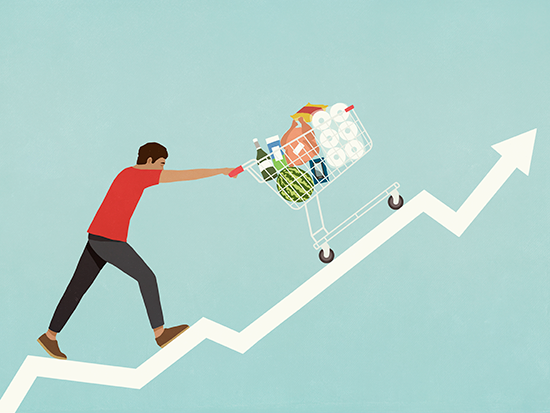
Inflation. It is one of the most commonly heard terms right now, but many people are unfamiliar with what it means. While most Americans are feeling prices’ going up steadily at the store or the gas pump, few have an understanding about what causes inflation, what to expect or how to gauge for the future.
University of Alabama at Birmingham economists Ben Meadows, Ph.D., and Joshua Robinson, Ph.D., from the Collat School of Business weigh in on what is happening with inflation, how the average person can better understand the future of the economy and what the value of their dollar looks like moving forward.
Everyone is hearing the word “inflation” right now in the media, in conversations with friends or in the workplace; if nothing else, people know that almost all goods cost way more than they did a few months or even a year ago. Simply put, what is inflation?
Robinson: Inflation is when all prices are on the rise due to a common, external source; you cannot have inflation in an individual market. For example, if only gas prices were rising, then you would not call that inflation — the change could be due to some change in supply or demand (or both) in that market. When we experience inflation, the weighted prices of all goods are going up on average.
Meadows: Inflation is the aggregate rise in prices. From cars to gasoline, toys to food, inflation is when all prices in an economy rise. Typically, the Federal Reserve shoots for inflation to hit 2 percent so that people in the economy are incentivized to spend, invest or save, rather than clutch their cash tightly.
What is causing the rise in prices that the average person is seeing?
Meadows: The current spike in inflation we’re seeing is highly contentious in the public forum. While supply chain bottlenecks — for instance, gasoline refineries — do have a small role to play, the amount of money floating in the economy is the major cause. Quite simply, there are more dollars chasing the same amount of goods in the economy.
A lot of people are curious: How did we get here?
Meadows: It is tremendously important to remember how we got here. No one created inflation to tank the economy, slash someone’s portfolio or create turmoil in the world. Instead, the major economies of the world faced a threat the modern world hasn’t seen before — a pandemic. It literally forced entire sectors of the economy. Crucially, we need to remember all the businesses that were shutting down while ICUs were filling up in spring 2020.
This presented an economic problem — tradeoffs. We could let businesses, airlines, entire sectors go under as demand for products and services were bludgeoned by the initial response, or we could artificially stoke demand to help businesses through. And this is paramount — we know how to fight inflation. We don’t know how to resurrect entire sectors of the economy that are valuable, yet unusable in the depths of a new pandemic. So, the choice was made to push the American economy through those times, and now inflation is a byproduct of those choices.
Does inflation ever trend back down? Or are these prices here to stay?
Meadows: Deflation is typically rare in an economy; it can actually be dangerous as it incentivizes folks to clutch their money tightly, since each dollar will be worth more in the future. What’s more likely is that inflation stabilizes where the general rise in prices slows to a predictable and perhaps unnoticeable level.
Robinson: Prices rarely come down unless there is something very wrong with the economy. The Federal Reserve’s monetary policy actions are always trying to keep us at a low level of inflation because of the severe negative consequences of deflation. Some prices of goods like cars, cereals and bread are examples of products mainly due to supply-chain issues and will come back down, but the overall monthly budget is unlikely to drop back to its pre-pandemic level unless we end up in a severe recession.
As costs increase, historically does this lead to a trend in increased wages to ease the burden people face?
Robinson: Yes, wages tend to be what economists call “sticky” — that is, they tend to lag behind other prices changes. That is because wage increases are usually a reaction to other price increases. Right now, although wages are going up, on average they are not keeping up with inflation. This means that, in actuality, wages are falling. If we follow historical patterns, though, workers will start demanding larger wage increases.
Meadows: In the last bout of inflation, yes. We just have forgotten those days since we’ve been living in 40 years of boring inflation numbers. Back then, it was quite normal to negotiate with your boss for yearly cost-of-living adjustments.
Does inflation mean that the value of the dollar has changed?
Meadows: It depends on what you’re comparing against. Compared against itself, say 2019 dollars versus 2022 dollars, then, yes, the value of the dollar has gone down. You can buy less with one dollar than you could in 2019. However, comparing against other currencies that are also facing inflation? That picture is a lot less clear.
Robinson: Yes, if you earned a dollar prior a year ago, then that dollar would only buy today the equivalent of 91 cents’ worth of goods a year ago.